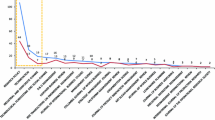Abstract
The paper presents a methodology called hybrid documents co-citation analysis, for studying the interaction between science and technology in technology diffusion. Our approach rests mostly on patent citation, cluster analysis and network analysis. More specifically, with the patents citing Smalley RE in Derwent innovations index as the data sets, the paper implemented hybrid documents co-citation network through two procedures. Then spectrum cluster algorithm was used to reveal the knowledge structure in technology diffusion. After that, with the concordance between network properties and technology diffusion mechanisms, three indicators containing degree, betweenness and citation half-life, were calculated to discuss the basic documents in the pivotal position during the technology diffusion. At last, the paper summarized the hybrid documents co-citation analysis in practise, thus concluded that science and technology undertook different functions and acted dominatingly in the different period of technology diffusion, though they were co-activity all the time.



Similar content being viewed by others
References
Alencar, M., Porter, A., & Antunes, A. (2007). Nanopatenting patterns in relation to product life cycle. Technological Forecasting and Social Change, 74(9), 1661–1680.
Baker, S., & Aston, A. (2005). The business of nanotech. Business Week, 64–71.
Bhattacharya, S., Kretschmer, H., & Meyer, M. (2003). Characterizing intellectual spaces between science and technology. Scientometrics, 58(2), 369–390.
Burton, R., & Kebler, R. (1960). The “half-life” of some scientific and technical literatures. American Documentation, 11(1), 18–22.
Chang, S., Lai, K., & Chang, S. (2009). Exploring technology diffusion and classification of business methods: Using the patent citation network. Technological Forecasting and Social Change, 76(1), 107–117.
Chen, C. (2004). Searching for intellectual turning points: Progressive knowledge domain visualization. Proceedings of the National academy of Sciences of the United States of America, 101(Suppl 1), 5303.
Chen, C. (2006). CiteSpace II: Detecting and visualizing emerging trends and transient patterns in scientific literature. Journal of the American Society for Information Science and Technology, 57(3), 359–377.
Chen, C., Ibekwe SanJuan, F., & Hou, J. (2010a). The structure and dynamics of cocitation clusters: A multiple-perspective cocitation analysis. Journal of the American Society for Information Science and Technology, 61(7), 1386–1409.
Chen, C., Zhang, J., & Vogeley, M. S. (2010b). Making sense of the evolution of a scientific domain: a visual analytic study of the Sloan Digital Sky Survey research. Scientometrics, 83(3), 669–688.
Hullmann, A., & Meyer, M. (2003). Publications and patents in nanotechnology. Scientometrics, 58(3), 507–527.
Jaffe, A., Trajtenberg, M., & Henderson, R. (1993). Geographic localization of knowledge spillovers as evidenced by patent citations. The Quarterly Journal of Economics, 108(3), 577–598.
Lee, M., Kim, K., & Cho, Y. (2010a). A study on the relationship between technology diffusion and new product diffusion. Technological Forecasting and Social Change, 77(5), 796–802.
Lee, P., Su, H., & Wu, F. (2010b). Quantitative mapping of patented technology—The case of electrical conducting polymer nanocomposite. Technological Forecasting and Social Change, 77(3), 466–478.
Meyer, M., Debackere, K., & Glanzel, W. (2010). Can applied science be ‘good science’? Exploring the relationship between patent citations and citation impact in nanoscience. Scientometrics, 85(2), 527–539.
Narin, F., Hamilton, K., & Olivastro, D. (1997). The increasing linkage between US technology and public science. Research Policy, 26(3), 317–330.
Narin, F., & Noma, E. (1985). Is technology becoming science? Scientometrics, 7(3), 369–381.
Narin, F., & Olivastro, D. (1998). Linkage between patents and papers: An interim EPO/US comparison. Scientometrics, 41(1), 51–59.
Nock, R., & Nielsen, F. (2006). On weighting clustering. IEEE transactions on pattern analysis and machine intelligence, 28, 1223–1235.
Noh, K., Kim, W., Kwon, O., Yae, Y., & Choi, H. (2007). Tracing knowledge flows using science and technology indicators. Information-Yamaguchi, 10(3), 327.
Park, H. W., & Kang, J. (2009). Patterns of scientific and technological knowledge flows based on scientific papers and patents. Scientometrics, 81(3), 811–820.
Park, G., & Park, Y. (2006). On the measurement of patent stock as knowledge indicators. Technological Forecasting and Social Change, 73(7), 793–812.
Roco, M. (2005). International perspective on government nanotechnology funding in 2005. Journal of Nanoparticle Research, 7(6), 707–712.
Small, H. (1973). Co-citation in the scientific literature: A new measure of the relationship between two documents. Journal of the American society for information science, 24(4), 265–269.
Small, H., & Griffith, B. (1974). The structure of scientific literatures I: Identifying and graphing specialties. Science studies, 4, 17–40.
Stolpe, M. (2002). Determinants of knowledge diffusion as evidenced in patent data: the case of liquid crystal display technology* 1. Research Policy, 31(7), 1181–1198.
Sung, K., Kim, T., & Kong, H. (2010). Microscopic approach to evaluating technological convergence using patent citation analysis. U-and E-Service, Science and Technology (pp. 188–194).
Von Luxburg, U. (2007). A tutorial on spectral clustering. Statistics and Computing, 17(4), 395–416.
Yoon, J., & Kim, K. (2011). Identifying rapidly evolving technological trends for R&D planning using SAO-based semantic patent networks. Scientometrics, 88(1), 213–228.
Acknowledgments
This paper was initiated at the 13th ISSI Conference, Duban, South Africa. The authors would like to thank the anonymous referees for their helpful comments. And the authors also like to acknowledge the financial support from the National Social Science Foundation of China (Project No.08BTQ025) and Specialized Research Fund for the Doctoral Program of Higher Education (SRFDP) (20110041110034).
Author information
Authors and Affiliations
Corresponding author
Rights and permissions
About this article
Cite this article
Gao, Jp., Ding, K., Teng, L. et al. Hybrid documents co-citation analysis: making sense of the interaction between science and technology in technology diffusion. Scientometrics 93, 459–471 (2012). https://doi.org/10.1007/s11192-012-0691-z
Received:
Published:
Issue Date:
DOI: https://doi.org/10.1007/s11192-012-0691-z




